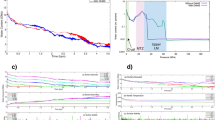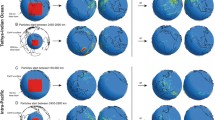Abstract
There is ongoing controversy as to the dynamical significance of geothermal heat flow in shaping the abyssal circulation. In this paper, we gauge the impact of geothermal heating and vertical mixing parameterizations in the general circulation model OPA. The experiments are evaluated by comparing simulated mantle 3He with observations collected during the GEOSECS and WOCE programs. This tracer is particularly adapted to the validation of our numerical simulations because its injection into the ocean interior is tightly linked to geothermal processes. In agreement with previous studies, the model circulation is found very sensitive to the parameterization of the vertical mixing. The meridional overturning circulation (MOC) is globally intensified when moving from a constant mixing to a version with enhanced mixing near the ocean bottom, with the most drastic variation observed for AABW (+ 50%). Adding the geothermal heat flux mainly affects AABW circulation in the model, enhancing it all the more as the meridional circulation is slow (low vertical mixing), but proportionally less so when it is more vigorous (enhanced vertical mixing). This can be understood from the requirement of the abyssal ocean to maintain heat balance. The evaluation with mantle 3He simulations reveals that the version with low vertical mixing, with its sluggish circulation, produces unrealistically high a 3He isotopic composition. However, with a vertical mixing that is enhanced at depth, the 3He distribution falls within an acceptable range of values in the deep ocean. Finally, adding the geothermal heating to this enhanced mixing case provides a substantial improvement of the simulation of AABW in all basins but the Indian Ocean. 3He isotopic composition is then in good agreement with the observations. Taken jointly with observational estimates of the MOC intensity, these independent isotopic constraints suggest that both geothermal heating and enhanced diapycnal mixing at depth are key ingredients in the realistic simulation of abyssal circulation.
Similar content being viewed by others
References
Adcroft A, Scott J, Marotzke J (2001) Impact of geothermal heating on the global ocean circulation. Geophys Res Lett 28: 1735–1738
Adkins JF, Ingersoll AP, Pasquero C (2005) Rapid climate change and conditional instability of the glacial deep ocean from the thermobaric effect and geothermal heating. Q Sci Rev 24: 581–594
Beckmann A, Döscher R (1997) A method for improved representation of dense water spreading over topography in geopotential-coordinate models. J Phys Oceanogr 27: 581–591
Blanke B, Delecluse P (1993) Variability of the tropical ocean simulated by a general circulation model with mixed layer-physics. J Phys Oceanogr 23: 1363–1388
Böning CW, Holland WR, Bryan FO, Danabasoglu G, McWilliams JC (1995) An overlooked problem in model simulations of the thermohaline circulation and heat transport in the Atlantic Ocean. J Clim 8: 515–523
Broecker WS, Peng TH (1982) Tracers in the sea, Lamont Doherty Geological Observatory. Palisades, New York, pp 690
Bryan F (1987) Parameter sensitivity of primitive equation ocean general circulation models. J Phys Oceanogr 17: 970
Craig H, Clarke WB, Beg MA (1975) Excess 3He in deep water on the east Pacific rise. Earth Planet Sci Lett 26: 125–132
Danabasoglu G, MCWilliams JC, Gent PR (1994) The role of mesoscale tracer transports in global ocean crirculation. Science 264: 1123–1126
Duffy PB, Caldeira K, Selvaggi J, Hoffert MI (1997) Effects of subgrid-scale mixing parametrisations on simulated distributions of natural 14C, temperature and salinity in a three-dimensional ocean general circulation model. J Phys Oceanogr 27: 498–523
Dutay J-C, Bullister JL, Doney SC, Orr JC, Najjar R, Caldeira K, Campin J-M, Drange H, Follows M, Gao Y, Gruber N, Hecht MW, Ishida A, Joos F, Lindsay K, Madec G, Maier-Reimer E, Marshall JC, Matear RJ, Monfray P, Mouchet A, Plattner G-K, Sarmiento J, Schlitzer R, Slater R, Totterdell IJ, Weirig M-F, Yamanaka Y, Yool A (2002) Evaluation of ocean model ventilation with cfc-11: comparison of 13 global ocean models. Ocean Model 4: 89–120
Dutay J-C, Jean-Baptiste P, Campin JM, Ishida A, Maier-Reimer E, Matear RJ, Mouchet A, Totterdell IJ, Yamanaka Y, Rodgers K, Madec G, Orr JC (2004) Evaluation of OCMIP-2 ocean model’s deep circulation with mantle 3He. J Mar Syst 48: 15–36
Emile-Geay J, Madec G (2009) Geothermal heating, diapycnal mixing, and the abyssal circulation. Ocean Sci 5: 203–218
England MH, Hirst AC (1997) Chlorofluorocarbon uptake in a world ocean model 2. Sensitivity to surface thermohaline forcing and subsurface mixing parameterizations. J Geophys Res 102: 15709–15731
England M, Holloway G (1998) Simulations of cfc content and water mass age in the deep north Atlantic. J Geophys Res 103: 15885–15901
England MH, Rahmstorf S (1999) Sensitivity of ventilation rates and radiocarbon uptake to subgrid-scale mixing in ocean models. J Phys Oceanogr 29: 2802–2827
Farley KA, Maier-Reimer E, Schlosser P, Broecker WS (1995) Constraints on mantle 3He fluxes and deep-sea circulation from an oceanic general circulation model. J Geophys Res 100: 3829–3839
Ganachaud A (2003) Large-scale mass transports, water mass formation, and diffusivities from world ocean circulation experiment (WOCE) hydrographic data. J Geophys Res 108. doi:10.1029/2002JC001565
Ganachaud A, Wunsch C, Marotzke J, Toole J (2000) Meridional overturning and large-scale circulation of the Indian Ocean. J Geophys Res 105: 26117–26134
Gent PR, Willebrand J, McDougall TJ, McWilliams JC (1995) Parameterizing eddy-induced tracer transports in ocean circulation models. J Phys Oceanogr 25: 463–474
Goosse H, Campin JM, Fichefet T, Deleersnijder E (1997) Impact of sea-ice formation on the properties of Antarctic bottom water. Ann Glaciol 25: 276–281
Iudicone D, Madec G, Blanke B, Speich S (2008) The role of the southern ocean surface forcings and mixing in the global conveyor belt. J Phys Oceanogr 38: 1357–1376
Iudicone D, Speich S, Madec G, Blanke B (2008) The global conveyor belt from a southern ocean perspective. J Phys Oceanogr 38: 1401–1425
Jayne SR, Laurent LCS (2001) Parameterizing tidal dissipation over rough topography. Geophys Res Lett 28: 811–814
Jean-Baptiste P (1992) Helium-3 distribution in the deep world ocean: its relation to hydrothermal 3He fluxes and to terrestrial heat budget. In: Consultants meeting on isotopes of noble gases as tracers in environmental studies, Vienna
Joyce T, Warren B, Talley L (1986) The geothermal heating of the abyssal subarctic Pacific Ocean. Deep Sea Res 33(8): 1003–1015
Kamenkovich IV, Goodman PJ (2000) The dependence of AABW transport in the Atlantic on vertical diffusivity. Geophys Res Lett 27: 3739–3742
Lupton JE (1995) Hydrothermal plumes: near and far field. In: Humphris S, Zierenberg R, Mullineaux L, Thomson R (eds) Seafloor hydrothermal systems: physical, chemical, biological, and geological interactions. Geophysical Monograph 91. American Geophysical Union, Washington, DC, pp 317–346
Lupton JE (1996) A far-field hydrothermal plume from Loihi Seamount. Science 272: 976–979
Lupton JE (1998) Hydrothermal helium plumes in the Pacific Ocean. J Geophys Res 103: 15853–15868
Lupton JE, Craig H (1981) A major helium-3 source at 15°S on the east pacific rise. Science 214: 13–18
Madec G, Imbard M (1996) A global ocean mesh to overcome the north pole singularity. Clim Dyn 12: 381–388
Madec G, Delecluse P, Imbard M, Lévy C (1998) Opa8.1 ocean general circulation model reference manual. Notes du pôle de Modélisation de l’IPSL 11
Müller RD, Roest WR, Royer J-Y, Gahagan LM, Sclater JG (1997) Digital isochrons of the ocean floor. J Geophys Res 102(32): 3211–3214
Munk W, Wunsch C (1998) Abyssal recipes II: energetics of tidal and wind mixing. Deep Sea Res 45: 1977–2010
Naveira Garabato AC, Stevens DP, Watson AJ, Roether W (2007) Short-circuiting of the oceanic overturning circulation in the Antarctic Circumpolar Current. Nature 447(7141): 194–197. doi:10.1038/nature05832
Orsi AH, Johnson GC, Bullister JL (1999) Circulation, mixing, and production of antarctic bottom water. Prog Oceanogr 43: 55–109
Palmer MD, Naveira Garabato AC, Stark JD, Hirschi JJ-M, Marotzke J (2007) The influence of diapycnal mixing on quasi-steady overturning states in the Indian Ocean. J Phys Oceanogr 37: 2290–2304
Paul A, Schäfer-Neth C (2003) Modeling the water masses of the Atlantic Ocean at the Last Glacial Maximum. Paleoceanography 18(3): 1058. doi:10.1029/2002PA000783
Rahmstorf S (2002) Ocean circulation and climate during the past 120,000 years. Nature 419: 207–214
Robbins PE, Toole JM (1997) The dissolved silica budget as a constraint on the meridional overturning circulation of the Indian Ocean. Deep Sea Res I 44: 879–906
Roullet G, Madec G (2000) Salt conservation, free surface and varying volume: a new formulation for ocean GCMs. J Geophys Res 105: 23927–23942
Schmitz WJ Jr (1995) On the interbasin-scale thermohaline circulation. Rev Geophys 33: 151–173
Schlösser P, Bullister JL, Fine R, Jenkins WJ, Key R, Lupton J, Roether W, Smethie W (2001) Transformation and age of water masses. In: Siedler G, Church J, Gould J (eds) Ocean circulation and climate. Academic Press, San Diego
Scott J, Marotzke J, Adcroft A (2001) Geothermal heating and its influence on the meridional overturning circulation. J Geophys Res 106: 1–14
Sloyan BM, Rintoul SR (2001) The southern ocean limb of global deep overturning circulation. J Phys Oceanogr 31: 143–173
Srinivasan A, Top Z, Schlosser P, Hohmann R, Iskandarani M, Olson DB, Lupton JE, Jenkins WJ (2004) Mantle 3He distribution and deep circulation in the Indian Ocean. J Geophys Res 109: C06012. doi:10.1029/2003JC002028
Stein CA, Stein S (1992) A model for the global variation in oceanic depth and heat flow with lithospheric age. Nature 359: 123–129
Stommel H (1982) Is the south Pacific helium-3 plume dynamically active?. Earth Planet Sci Lett 61: 63–67
Talley LD, Reid JL, Robbins PE (2003) Data-based meridional overturning streamfunctions for the global ocean. J Clim 16: 3213–3226
Toole JM, Warren BA (1993) A hydrographic section across the subtropical south Indian Ocean. Deep Sea Res I 40: 1973–2019
Urakawa LS, Hasumi H (2009) A remote effect of geothermal heat on the global thermohaline circulation. J Geophys Res 114: C07016. doi:10.1029/2008JC005192
Visbeck M (2002) Climate—the ocean’s role in Atlantic climate variability. Science 297(5590): 2223–2224
Visbeck M (2007) Concept oceanography: power of pull. Nature 447: 383. doi:10.1038/447383a
Wanninkhof R (1992) Relationship between wind speed and gaz exchange over the ocean. J Geophys Res 97: 7373–7382
Weber SL, Drijfhout SS, Abe-Ouchi A, Crucifix M, Eby M et al (2007) The modern and glacial overturning circulation in the Atlantic ocean in PMIP coupled model simulations. Clim Past 3: 51–64
Wijffels SE, Toole JM, Bryden HL, Fine RA, Jenkins WJ, Bullister JL (1996) The water masses and circulation at 10N in the Pacific. Deep Sea Res 43: 501–544
Wunsch C, Ferrari R (2004) Vertical mixing, energy, and the general circulation of the oceans. Annu Rev Fluid Mech 36: 281–314
Author information
Authors and Affiliations
Corresponding author
Rights and permissions
About this article
Cite this article
Dutay, JC., Emile-Geay, J., Iudicone, D. et al. Helium isotopic constraints on simulated ocean circulations: implications for abyssal theories. Environ Fluid Mech 10, 257–273 (2010). https://doi.org/10.1007/s10652-009-9159-y
Received:
Accepted:
Published:
Issue Date:
DOI: https://doi.org/10.1007/s10652-009-9159-y




